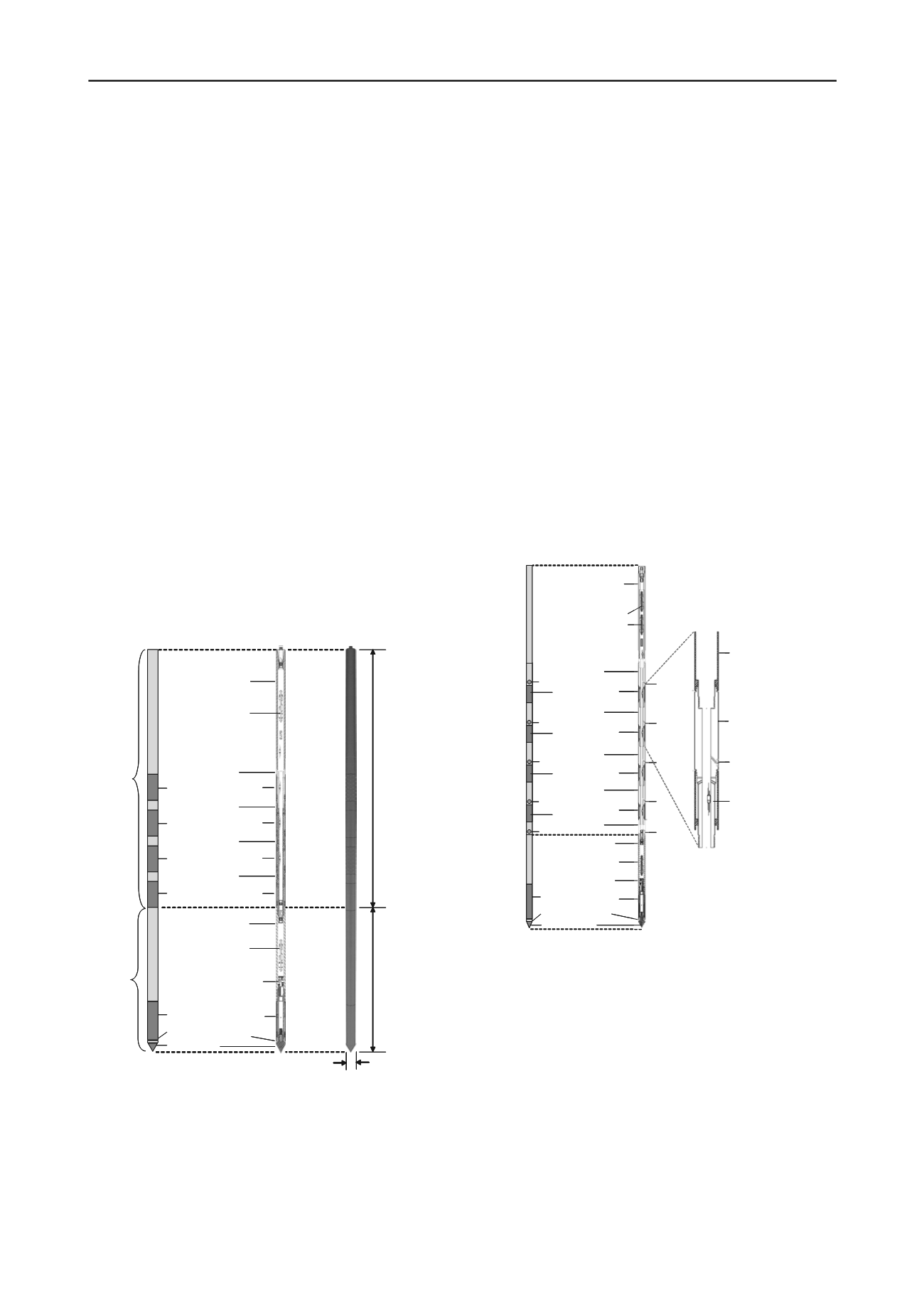
528
Proceedings of the 18
th
International Conference on Soil Mechanics and Geotechnical Engineering, Paris 2013
2.1 First Generation: Multi-sleeve Friction Attachment
(MFA).
The first generation of multi sensor attachments
deviates from the standard CPT in that the MFA is capable
of measuring four different friction sleeve stresses in
addition to the standard CPT measurements (q
t
, f
s
, u
2
). Each
sleeve position offers the possibility of being equipped with
a sleeve of different roughness, with the intention of
inducing different degrees of shearing in the soil. Figure 1
shows a schematic of the MFA. According to studies
conducted by Frost and DeJong (2005), the standard smooth
CPT friction sleeve measurement is more indicative of soil
sliding against the sleeve as opposed to shearing against the
soil. The reason is that the conventional CPT friction sleeves
are manufactured with an intentionally smooth surface. As a
consequence of the MFA’s multi-sensor configuration, the
device is able to determine the end bearing capacity of the
soil and the relationship between interface shear strength
resistance and surface texture in a single sounding. The
important relationship between interface shear strength and
surface roughness was originally identified through
laboratory tests by Uesugi and Kishida (1986).
2.2 Second Generation: Multi-sleeve Piezo-Friction
Attachment (MPFA).
The second generation of multiple
sensor devices offers the ability to directly measure the
interface response over a range of counterface profiles,
while simultaneously measuring the excess pore water
pressure ahead of and after each friction sleeve as the device
is advanced into the subsurface. This is achieved by means
of its four independent load cells attached to the textured
sleeves and five independent dynamic pore pressure sensors.
Conventional 15 cm
2
CPT Module
Multi-Friction Sleeve
Penetrometer Attachment
q
c
f
s
f
s
#1
u
2
f
s
#2
f
s
#3
f
s
#4
Attachment
Digital
Housing
Attachment
Digital
Board
Digital
Housing
Digital
Board
Dual Axis
Inclinometer
Friction Sleeve
Tip
Pore Pressure
61 cm
109 cm
Friction Sleeve
Friction Sleeve
Friction Sleeve
Friction Sleeve
Mandrel
Mandrel
Mandrel
Mandrel
4.37 cm
Figure 1. Schematic of the multi-sleeve friction penetrometer along
with a standard CPT module.
The coupling of axial load and pore pressure sensors gives
the MPFA the ability to provide a direct measure of pore
water pressure generation due to shearing against surfaces of
different roughnesses. Several advantages offered by the
MPFA are the ability to consider the measured interface
response data within an effective stress framework which is
useful for applications such as liquefaction as well as
strength degradation, flow and consolidation characteristics
along the penetrometer’s shaft, more detailed data for
improved stratigraphy profiling, and the ability to
distinguish between drained, undrained and partially drained
conditions at the various sensor locations (Hebeler, 2005).
Figure 2 shows a schematic of the MPFA. Examples of the
unique insights resulting from the multi-sleeve sensor
technology include in-situ determination of the relationship
between interface friction and sleeve surface roughness
(Figure 3) and soil classification using interface behavior
(Figure 4).
3 PROPOSED SITE CHARACTERIZATION TOOL
3.1. Third Generation: Multi-sleeve Piezo-Friction-Torsion
Attachment (MPFTA).
The third generation of multi-sensor
devices being developed at the Georgia Institute of
Technology incorporates both axial and torsional shear as
well as pore pressure sensing capabilities.
f
s
f
a1
u
2
f
a2
f
a3
f
a4
Attachment
Digital
Housing
Digital Housing
u
a1
u
a0
u
a4
u
a3
u
a2
q
c
Friction Sleeve
Pore Pressure
Tip Load
Dual Axis
Inclinometer
Digital
Board
Attachment
Digital
Boards
Friction
Sleeve
Friction
Sleeve
Friction
Sleeve
Friction
Sleeve
Mandrel
Mandrel
Mandrel
Mandrel
Mandrel
Piezo
Sensor
Piezo
Sensor
Piezo
Sensor
Piezo
Sensor
Piezo
Sensor
Attachment
Sleeve
Mandrel
Replaceable
Attachment
Friction
Sleeve
Attachment
Individual
Load Cell
Attachment
Individual
Piezo Sensor
(0.67)
(0.81)
(0.88)
(1.07)
(1.14)
(1.33)
(1.40)
(1.59)
(1.66)
(a) (b)
Figure 2. Schematic of the multi-piezo-sleeve friction penetrometer
along with a standard CPT module (a) schematic - brackets indicate
sensor offset from tip in meters and (b) piezo friction sleeve
mandrel design detail.
Its dimensions and external characteristics, with and without
pore pressure sensing capabilities, are similar to the MFA
and MPFA shown in Figures 1 and 2, respectively. However,
the new concept incorporated into the device consists of a
dual load-torsion cell being installed in each sleeve module


